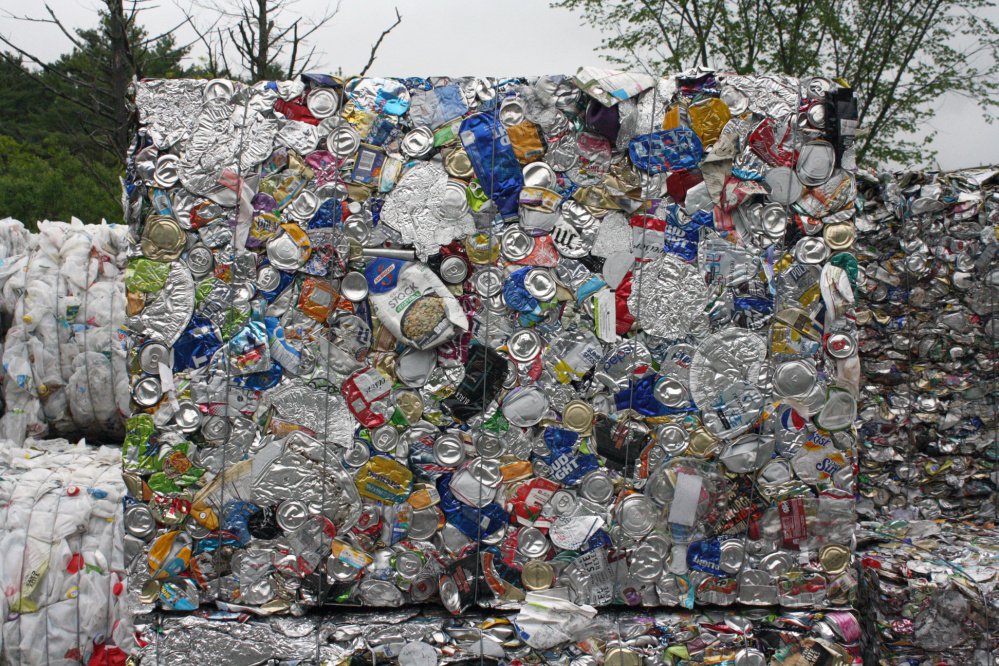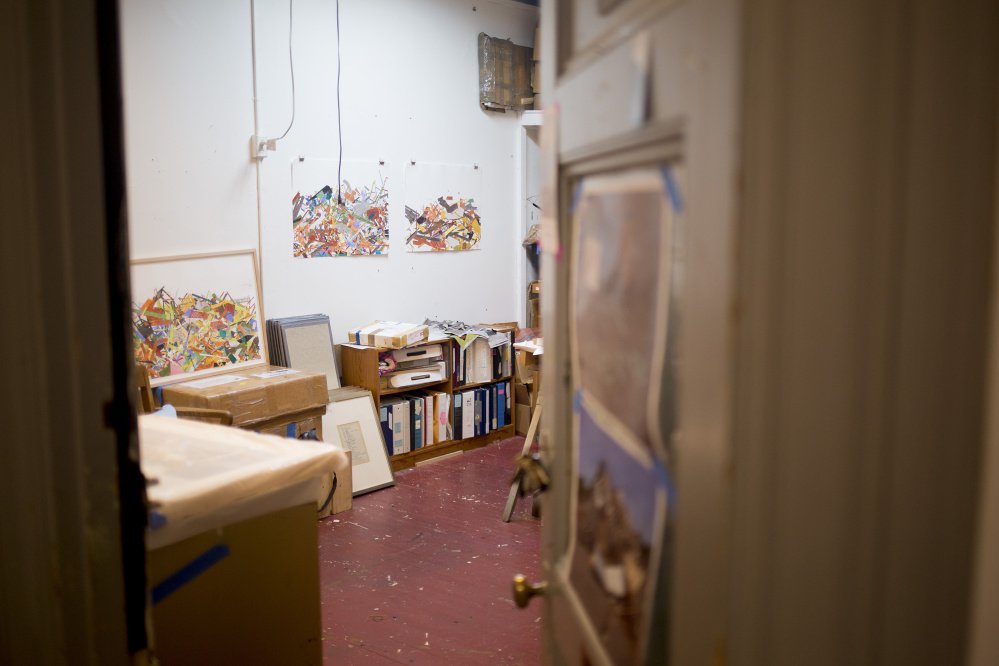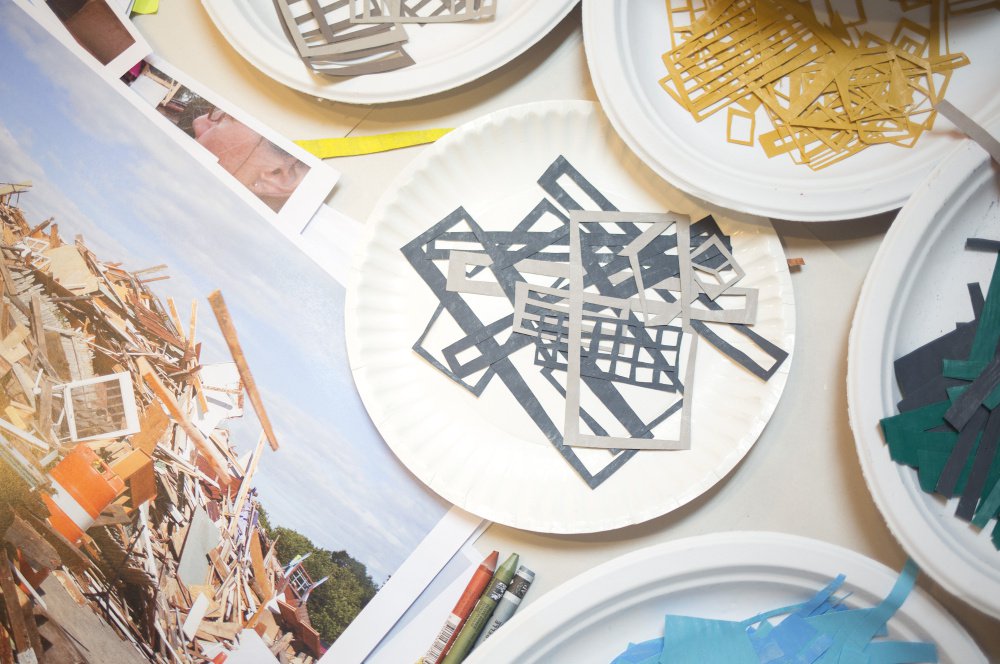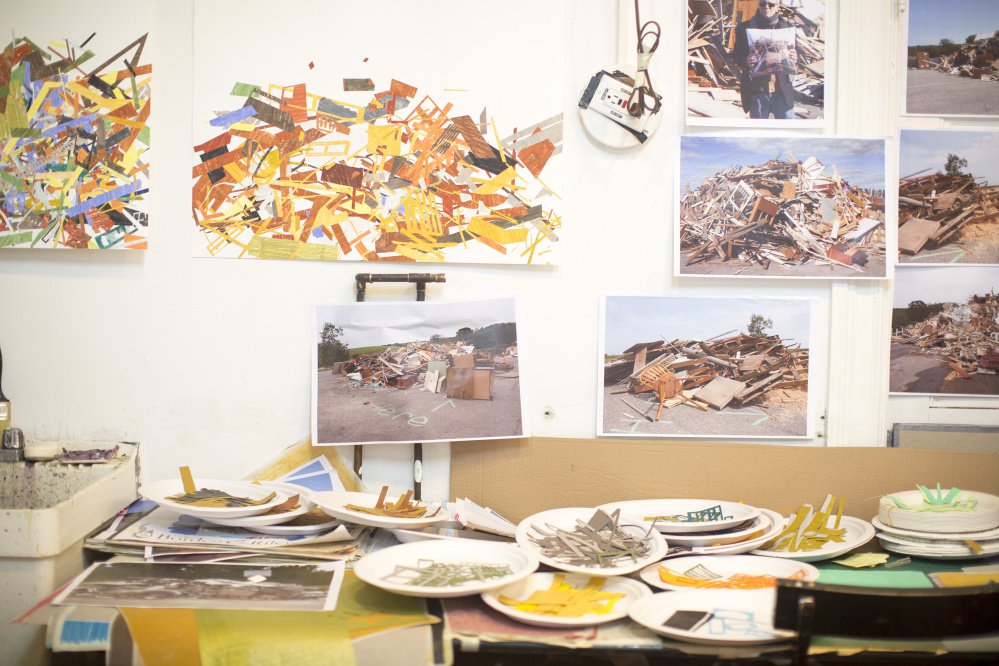The death of her dog, Browser, crumpled Adriane Herman. She was sorting through the emotional baggage of a difficult spell in her life that included a divorce and issues with work and family. When Browser died in June 2014, Herman was brought to her knees, confronted with a toll so heavy she had no choice but to begin letting go of things, emotionally and physically.
Herman, an interdisciplinary artist from Cape Elizabeth who teaches visual art at Maine College of Art, began spending time at the landfill, and grew ever more curious about the parade of people who drove up in their cars and trucks and unloaded piles of trash, debris and personal belongings – the detritus of life and other things far more personal.
She watched as they threw their stuff into the bins and piles, drawn by their gestures of release and inspired by their ability to shed. “The tide comes in and washes out, and it brings things in and cleans things out. But humans tend to hold on to things. We don’t tend to let things go until we’re forced to,” she said.
At the dump, Herman began to learn to let go and process the grief in her life. “I let go of my dog. If I could let go of my dog, I could let go of anything,” she said.
The process of letting go led Herman to her latest art project, “Out of Sorts,” an exhibition at Speedwell Projects in Portland that will explore the cycle of consumption, release and recycling, both physically and emotionally.
It opens Sept. 16, and is the latest in a long series of exhibitions and projects in Maine and the Midwest that Herman has mounted related to the themes of consumption and letting go. She recently closed an exhibition of prints inspired by her time at the landfill in Cape Elizabeth.
Herman, 50, has shown her art at the Portland Museum of Art, Center for Maine Contemporary Art and the Brooklyn Museum, and is in the collection of the Whitney Museum of American Art in New York.
THINK, SHED AND SAVE
“Out of Sorts” is about how and why we recycle in our physical and emotional landscapes, and asks viewers to consider consumption from a personal, community and global perspective. She wants people to think “about how we eat, drink, work, play and clean,” and the attention we pay to the implications of disposability and excess to the planet and our culture. She also wants to show people how they can reduce consumption and save money for their communities by recycling more wisely, and to help them plan strategies for personal release.
Among the items on view are five bales of recycled materials on loan from ecomaine, the nonprofit waste-management agency that handles recycling across southern Maine, as well as photos of Herman’s of trash being incinerated and recycled material being sorted at ecomaine’s Portland plant. The exhibition will include benches made from salvaged wood and upholstered with fabric printed with Herman’s photographs.
On view through Oct. 14, “Out of Sorts” also will include several date-specific events. On Sept. 29, ecomaine’s Environmental Educator Katrina Venhuizen will talk about how to be better recyclers and the importance of composting food waste, and Herman has scheduled what she calls “witnessed releases” – opportunities for people to shed emotions and possessions they are ready to live without.
The first, “Surrender Sunday” on Oct. 1, will create a place for people seeking to let go of something that weighs on them and talk privately with a sensitive and compassionate listener. She created a similar event last year on the Eastern Prom. When the exhibition closes Oct. 14, Herman will host an “Emotional Value Auction,” reprising an event she presented this spring when she was artist in residence in Yarmouth as part of a Kismet Foundation program.
The auction is a non-currency exchange between someone who wants to release something that holds emotional value or burden and another person who is interested in taking it on. The person disposing of the item writes up the story behind it, explaining why it’s meaningful. The bidder writes a statement about why they want it and their intention for it.
It becomes an emotional exchange of physical objects between strangers, said Jocelyn Lee, who owns Speedwell Projects and participated in Herman’s previous Emotional Value Auction at the Yarmouth History Center.
In Yarmouth, Lee offered a hand-blown glass perfume bottle, a gift from her mother when Lee was in high school. “It reflects my mother’s values around what we collect and keep in our homes and how we decorate,” Lee said in an interview. “It reflects class and taste, and my mother’s tastes are not my own. It’s very precious and Old World, and very fragile. I was constantly moving it so the cats wouldn’t knock it over. I kept moving it around. I hated it.”
But Lee didn’t hate her mother. She loved her mother very much, and when she died in 2008, Lee was devastated.
In her note to the potential bidder in Yarmouth, Lee wrote, “I offer this hand-blown dressing table perfume bottle as a way to purge, cleanse and reflect on my relationship with my mother. It’s been nine years since her death and I’m just beginning to look at the multitude of ways she’s impacted me.
“May someone find a use and purpose for this lovely object.”
And someone did.
MEANINGFUL EXCHANGE
The bidder, a 50-year mother of two, wrote that she was “called to the object” because of Lee’s awareness of the “deep complexities of the mother/daughter relationship.” She continued, “My mother is almost 80 and our relationship is a tapestry of joy and pain. It opens up space in me to look at this object, to think of its owner, and to hold in my own heart the universalities of the mother/daughter relationship.”
Katie Worthing, director of Yarmouth History Center, said the auction became a community-building event because it involved the exchange of personal stories. “It certainly brought people together in a way that hadn’t happened before. People met folks in town they hadn’t met before, and this very thoughtful community was created around this exchange. It was lovely.”
Worthing wasn’t sure about the idea at first. It was hard to explain, and a bit complicated. But people got it, and right away.
“There was an immediate acceptance of the idea,” she said. “People brought in things from their closets that they hadn’t used in years. We got a couple dozen objects that ran the whole gamut, from the ordinary – a purse or glass bottle – to others that were heirlooms, like a crochet bedspread. The bidders were very thoughtful, and it was really touching.”
The history center proved to be a perfect place for the exchange, because it functions as a site of release in its daily operation, Worthing said. “People come in all time with heirlooms and things that have been in their house that have emotional value connected to them. We take those objects in and tell their stories when we put them in exhibitions,” she said.
Venhuizen, the ecomaine educator who is working with Herman on “Out of Sorts,” readily accepted the challenge of talking about recycling in an art gallery, which will be a first for her. Her job requires a lot of community outreach, and she routinely arranges tours of the ecomaine plant. Last year, about 1,800 people took the tour. Herman’s art installation will allow ecomaine to reach a different audience, she said.
Ecomaine is loaning Herman five recycled bales for the exhibition. She will have one bale of aluminum; two bales of No. 1 plastic, which are common drinking bottles; and two bales of Nos. 3-7 plastic, which include things like ketchup bottles and gallon jugs.
Herman and Venhuizen settled on those because they are dynamic and interesting to look at, and they’re not messy. “We thought they would be the least-smelly ones. Milk jugs and laundry detergent smell and may leak. We want to make sure the gallery is respected and that people will want to come in and not be turned off,” Venhuizen said.
Lee welcomes the bales into the gallery. “They’re actually beautiful objects,” she said. “They look like minimalist sculptures, but they are archaeological objects of our culture. From a distance, they are shiny and colorful, and they look like art. But then you come up close and you realize, this is all the stuff that we take for granted, get rid of and don’t think about again.”
Herman wants people to think about them again, so they act responsibly in their consumption and disposal. She calls them “communally created cubes.”
As an artist, her job is to make people ponder and think. She’s a problem solver and a teacher. In the press release for “Out of Sorts,” she calls herself an “experience broker.” She didn’t create the bales or use her artistic touch to enhance them. But it’s her vision to present them as art objects as a way to move people toward living more healthy lifestyles, personally and communally.
GUT FEELING
Mo Dickens will attest to that. He lives in Kansas City, and met Herman when she taught at the Kansas City Art Institute 20 years ago. Herman returned as a senior lecturer in 2015. During her recent residency, her car broke down, and she hit Dickens up for rides to church every Sunday. Dickens was happy to help his friend, but not thrilled about going to church. Still, he picked her up every Sunday and began witnessing how Herman changes lives. At church, she began talking to parishioners about letting go of things, and arranged what she calls a “Freeing Throwers” event where people ceremoniously tossed things away and talked about what they were releasing.
Herman took photos as people talked and tossed.
One guy threw away his smartphone, and pledged to spend more time with his family. Another tossed medical bills. Herman convinced Dickens to give up junk food. “I have a reputation in Kansas City for eating crappy food, and a lot of it,” he said. “She got a picture of my hamburger box flying toward the Dumpster and my gut hanging out of my jacket. When I saw the picture, I said, ‘Geez, I didn’t think my gut was that big.’ ”
He lost 27 pounds in three months, and has kept the weight off. But they didn’t stop there. Together, Dickens and Herman applied for and received a grant that rewards innovative art projects in non-traditional places. They made posters of the “Freeing Throwers” event and placed them in Kansas City buses, and recorded audio ads that played on the buses’ PA systems encouraging riders to join Dickens in giving up junk food and donating to thrift shops. The ads were triggered by GPS, and timed to play near fast-food restaurants and second-hand stores.
Dickens cried as he talked about Herman’s impact on his life. “It was an adventure being a temporary artist,” he said, laughing to break the tension on the phone. “Getting my health in order was a powerful thing and something I had been needing to do. I have family members who are overweight and in some cases way overweight.”
Dickens thanks his friend in Maine each time he steps on the scale.
“Out of Sorts” feels especially apt right now, as piles of trash and people’s personal belongings pile up on the streets of Houston, lost to stormy weather. People are letting go, by the force of nature and by personal will.
“Letting go is very hard,” Herman said. “We can do it if we are forced to. We let go at a funeral. We let go of our stuff when we clean out a room and make room for the baby. But it’s very hard, and it becomes a ritualistic release.”
Staff Writer Bob Keyes can be contacted at 791-6457 or at:
bkeyes@pressherald.com
Twitter: pphbkeyes
Send questions/comments to the editors.









Comments are no longer available on this story